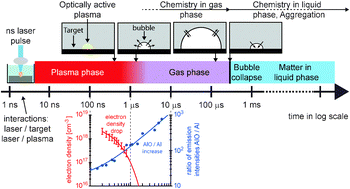γ-Al2O3 nanoparticles synthesised by pulsed laser ablation in liquids: a plasma analysis
Abstract
Pulsed laser ablation has proved its reliability for the synthesis of nano-particles and nano-structured materials, including metastable phases and complex stoichiometries. The possible nucleation of the nanoparticles in the gas phase and their growth has been little investigated, due to the difficulty of following the gas composition as well as the thermodynamic parameters. We show that such information can be obtained from the optically active plasma during its short lifetime, only a few microseconds for each laser pulse, as a result of a quick quenching due to the liquid environment. For this purpose, we follow the laser ablation of an α-Al2O3 target (corindon) in water, which leads to the synthesis of nanoparticles of γ-Al2O3. The AlO blue-green emission and the AlI 2P0–2S doublet emission provide the electron density, the density ratio between the Al atoms and AlO molecules, and the rotational and vibrational temperatures of the AlO molecules. These diagnostic considerations are discussed in the framework of theoretical studies from the literature (density functional theory). We have found that starting from a hot atomized gas, the nucleation cannot occur in the first microseconds. We also raise the question of the influence of water on the control of the stoichiometry.


 Please wait while we load your content...
Please wait while we load your content...